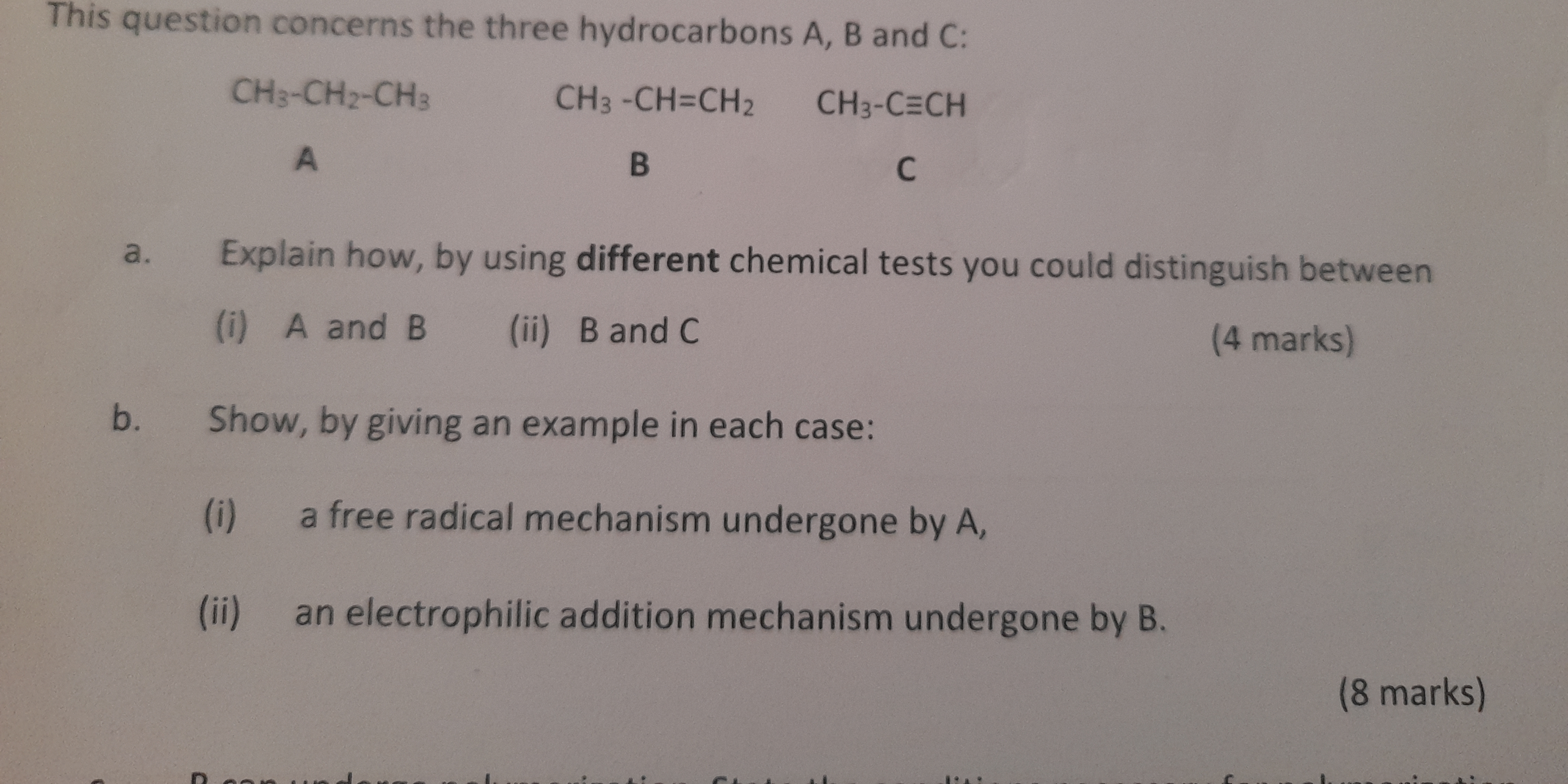This question concerns the three hydrocarbons A, B and C: a. Explain how, by using different chemical tests you could distinguish between (i) A and B (ii) B and C b. Show, by gi... This question concerns the three hydrocarbons A, B and C: a. Explain how, by using different chemical tests you could distinguish between (i) A and B (ii) B and C b. Show, by giving an example in each case: (i) a free radical mechanism undergone by A, (ii) an electrophilic addition mechanism undergone by B.

Understand the Problem
The question concerns three hydrocarbons, A, B, and C. It asks to explain how to distinguish between A and B, and B and C using chemical tests. It also asks to show, with an example, a free radical mechanism undergone by A and an electrophilic addition mechanism undergone by B.
Answer
a. (i) Bromine water test: B decolorizes, A doesn't. (ii) Ammoniacal silver nitrate: C forms white precipitate, B doesn't. b. (i) Propane + Cl2 (UV light) -> chloropropane + HCl (ii) Propene + HBr -> 2-bromopropane.
a. (i) To distinguish between A (propane) and B (propene), use bromine water. B will decolorize bromine water due to the presence of the double bond, while A will not react. (ii) To distinguish between B (propene) and C (propyne), use ammoniacal silver nitrate. C will form a white precipitate due to the terminal alkyne, while B will not react.
b. (i) A free radical mechanism of A (propane) can be shown through halogenation, for example, with Cl2 under UV light. (ii) An electrophilic addition mechanism of B (propene) can be shown through the addition of HBr, following Markovnikov's rule.
Answer for screen readers
a. (i) To distinguish between A (propane) and B (propene), use bromine water. B will decolorize bromine water due to the presence of the double bond, while A will not react. (ii) To distinguish between B (propene) and C (propyne), use ammoniacal silver nitrate. C will form a white precipitate due to the terminal alkyne, while B will not react.
b. (i) A free radical mechanism of A (propane) can be shown through halogenation, for example, with Cl2 under UV light. (ii) An electrophilic addition mechanism of B (propene) can be shown through the addition of HBr, following Markovnikov's rule.
More Information
The reaction with bromine water is a classic test for unsaturation (double or triple bonds) in organic compounds. Terminal alkynes (alkynes with a triple bond at the end of the carbon chain) have a slightly acidic hydrogen that can react with certain metal ions to form a precipitate.
Tips
A common mistake is not understanding the different reactivities of alkanes, alkenes, and alkynes. Also, confusing electrophilic addition and free radical mechanisms. Make sure to clearly show the initiation, propagation, and termination steps in free radical mechanisms and the attack of the electrophile in electrophilic addition.
Sources
- Alkanes & Cycloalkanes - MSU chemistry - .chemistry.msu.edu
- Selectivity in Free Radical Reactions: Bromination vs. Chlorination - masterorganicchemistry.com
- Hydroboration Oxidation of Alkenes - Master Organic Chemistry - masterorganicchemistry.com
AI-generated content may contain errors. Please verify critical information